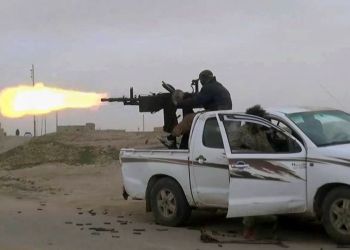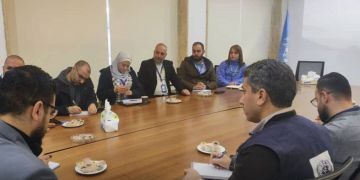This post is also available in:
![]() العربية
العربية
The entry of the Syrian Revolution its seventh year coincided with a group of factions from Deir Ezzor announcing a new military formation named ‘Deir Ezzor Miliatry Council’ in the countryside of Aleppo. However, before going into details concerning that formation, we should address the revolutionary phases in which Deir Ezzor province experienced peaceful protests, liberation and confrontations with the Islamic factions.
Deir Ezzor and the revolution
Deir Ezzor province has revolted against the Assad regime since the beginning of the Syrian Revolution. In the beginning, several peaceful protests were held for a couple of months until the regime increased its brutal crackdown on the protesters. As the number of civilian casualties mounted, a group of people from Deir Ezzor resorted to take up arms in order to protect the peaceful protests. Because heinous massacres against civilians continued, more people chose to join tiny anti-Assad military factions, which would later be the backbone of the Free Syrian Army in Deir Ezzor.
Deir Ezzor and the liberation:
A military confrontation with the Assad regime became inevitable due to the fact that they utilized heavy weapons to shell civilian populated areas in Deir Ezzor city and surrounding villages where people were calling for the overthrowing of the regime. Many rebels across the province became convinced with a military uprising against the regime and its allied militias, despite the fact that they were few in numbers and had no strategic weaponry. Their strong belief in the revolution’s principles and their hope for freedom and dignity were the alternatives for weapons which gave them the power to confront the regime, relying only upon basic weapons.
In the phase of the liberation of Deir Ezzor, the FSA factions in the province managed to liberate around 95 percent of the areas in it. It should be pointed out that at that time, some FSA groups were receiving a tiny support ( which was given by the peaceful protesters) by which they bought light weapons and ammo. Among the areas they liberated were the Hamdan Military Airport in the Al-Bukamal area, the Artillery Barrack in the Mayadin city, security branches inside Deir Ezzor city and many other military checkpoints across the province.
Al-Qaeda in Deir Ezzor
After the liberation of the eastern countryside of Deir Ezzor by the FSA, the Nusra Front began to appear, mainly in mid-2012. The propagation of the Nusra Front began by some FSA-affiliated youth who had met with Nusra Sheikhs and were brainwashed into their Jihadist ideology. Then, the front began collecting allegiance in villages where tribalism was dominant. Afterwards, they began confiscating some liberated oil fields, including the Koniko gas factory, to use them as their main source of incomes. This was followed by disfiguring the image of the FSA and weakening its military faction through the recruiting of their affiliates into the Nusra ranks.
Daesh in Deir Ezzor
The phase which preceded Daesh presence in Deir Ezzor was characterized by the Nusra dominating over the military operations in the province since FSA-linked brigades were not cooperating their activities which weakened them and paved the way for the Nusra to lead the show.
Daesh presence in Deir Ezzor began with a group of fighters whose number did not exceed 50. They had no experience in fight against the Assad regime. Their first battles were against brigades belonging to the FSA-linked Ahfad Rassul Brigade. Nusra, along with the Hamzah Battalion, planned the operations and the 50 fighters executed them. They attacked headquarters belonging to that brigade and succeeded in confiscating their weapons and capturing some of their commanders and fighters.
The FSA factions overlooked the gravity of the situation and showed no severe resistance to the organization following the attack on the Ahfad Rassul Brigade which enabled the organization to launch a general offensive and capture all the liberated areas in 20/07/2014.
The FSA after Daesh
After the capturing of the province by Daesh, FSA factions had multiple stances concerning the fight against the organization. Some pledged their allegiance after remaining neutral in the fight against the group, while some others chose to continue operating in Deir Ezzor and fighting the Assad regime under the command of Daesh. The biggest part of the FSA factions in Deir Ezzor chose to leave the province for other FSA-held areas in Syria, including the Qalamoun, the countryside of Deraa, Aleppo and the Syrian Badiya. Some factions were dissolved and their manpower returned to their normal life.
FSA fighters from Deir Ezzor have partaken other rebels in the fighting across all Syria. They have spelled their blood on all the Syrian soil, from the Latikiyah to Homs, Hama, Damascus, Aleppo and Idlib.
The Deir Ezzor’s FSA has become weak since their retreat from the province. They have become weak due to the fact that they do not cooperate with each other and are dispersed across different areas. In addition, all attempts to unify the DeirEzzor’s FSA factions were to no avail, simply because they are backed by different sponsors who do not have the serious intention to liberate the province of Deir Ezzor .
A military faction named the ‘Deir Ezzor Military Council’ was established recently. According to the official statement of the formation, the new entity is made up of around 10 tribes. However, Deir Ezzor people, including the rebels, have different stances on that formation. Some of them support it and see signs of hopes to liberate Deir Ezzor in it, while some oppose it for it is just the repeating of the previous mistakes which revolve around the not operating under one single command for being made up of multiple factions, each of each has a different plan. Moreover, major FSA factions from Deir Ezzor such as the Ahrar Sharqiyah factions, who are operating in northern Syria, are not part of the recently established council, which sparks concerns that there are no strong will and intention to unify those factions and liberate the province from both, Daesh and the Assad regime.










